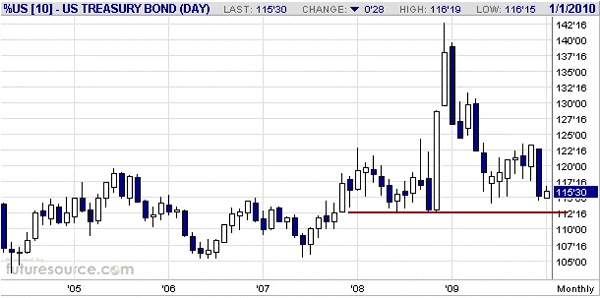Interest Rate Manipulation
Steve Saville
email: sas888_hk@yahoo.com
Jan 19, 2010
Below is an excerpt from a commentary originally posted at www.speculative-investor.com on 14th January, 2010.
What the "risk free" interest rate should be and what it actually is
The risk-free interest rate (the interest rate where the risk of direct default is close to zero) should reflect the economy-wide time preference, meaning that it should reflect the general desire to save (postpone consumption) relative to the general desire to consume. For example, a low interest rate would ideally indicate that there was a relatively high level of savings and that consumption was likely to be higher in the future than it is in the present. As such, it would act as a valid signal for businessmen to embark on long-term, capital-intensive projects in order to take advantage of both the current low cost of credit and the expected future rise in consumption.
Unfortunately, though, under the current system the interest rate has almost nothing to do with the economy-wide time preference. As a result: investing mistakes are made on a grand scale, the economy lurches between boom and bust in oscillations of ever-increasing amplitude, and real economic progress is slowed or stopped altogether. All of this was well understood and explained by Ludwig von Mises a century ago, but most of today's economists are completely in the dark.
Rather than providing businessmen, entrepreneurs and other investors with useful information regarding the overall level of savings, the risk-free interest rate is now dominated by central bank policy and inflation expectations. To be more specific, the short-term interest rate is set by the central bank and the long-term interest rate is determined by the combination of central bank manipulation and the market's inflation expectations. Consequently, the interest rate signal will now routinely be the OPPOSITE of what it would be in a genuinely free market. For example, under the current system it is common for the central bank to force the interest rate down to a low level at a time when there is also a relatively low level of savings, and for inflation expectations to force the interest rate upward at a time when the economy-wide savings level is relatively high.
We never cease to be amazed by the fact that people who are smart enough to understand why a committee should never be given the power to set the price of eggs believe that a committee should be given the power to set the price of credit.
When will the Fed begin to hike the overnight interest rate?
It is clear that the Fed's plan is to keep its interest rate target close to zero until there is a significant improvement in the US employment situation. It's not likely that there will be any improvement in the US employment situation over the next 12 months, so does this mean that the Fed Funds rate will remain near zero for at least another year?
Whether it does or not will largely be determined by inflation expectations. As the "Austrians" have always known and as the "Keynesians" discovered to their amazement during the 1970s, a high rate of unemployment will not prevent the prices of goods and services from rising in response to rapid money-supply growth. Rising prices lead to rising inflation expectations, and once inflation expectations exceed a certain level it will become necessary for the Fed to hike its targeted interest rate regardless of what the employment situation happens to be at the time. The reason is that if the Fed refuses to boost the overnight interest rate in the face of rising inflation expectations, then long-term interest rates -- including interest rates on adjustable-rate home mortgages -- will begin to accelerate upward.
That is, in the absence of a meaningful increase in employment the start of the Fed's next rate-hiking campaign will be determined by inflation expectations. The question, then, is: how will we know when inflation expectations have exceeded the level at which a Fed rate hike will be deemed necessary? We suspect that the 'tipping point' will be a decisive break below the support line (the base of the multi-year topping formation) drawn on the following monthly T-Bond chart.

Anticipation of a Fed rate-hiking campaign could be an excuse for an intermediate-term gold correction at some point, but there is almost no chance that the Fed will become 'tight' enough to end gold's long-term upward trend. In our opinion, an extension of gold's bull market to at least 2013-2014 is 'baked into the cake' based on the money-supply growth that has already occurred.
###
Steve Saville
 email: sas888_hk@yahoo.com email: sas888_hk@yahoo.com
Hong Kong Regular financial market forecasts and analyses are provided at our web site:
http://www.speculative-investor.com/new/index.html. We aren't offering a free trial subscription at this time, but free samples of our work (excerpts from our regular commentaries) can be viewed at: http://tsi-blog.com
Copyright ©2002-2019 speculative-investor.com All Rights Reserved. Saville Archives
321gold Ltd

|

